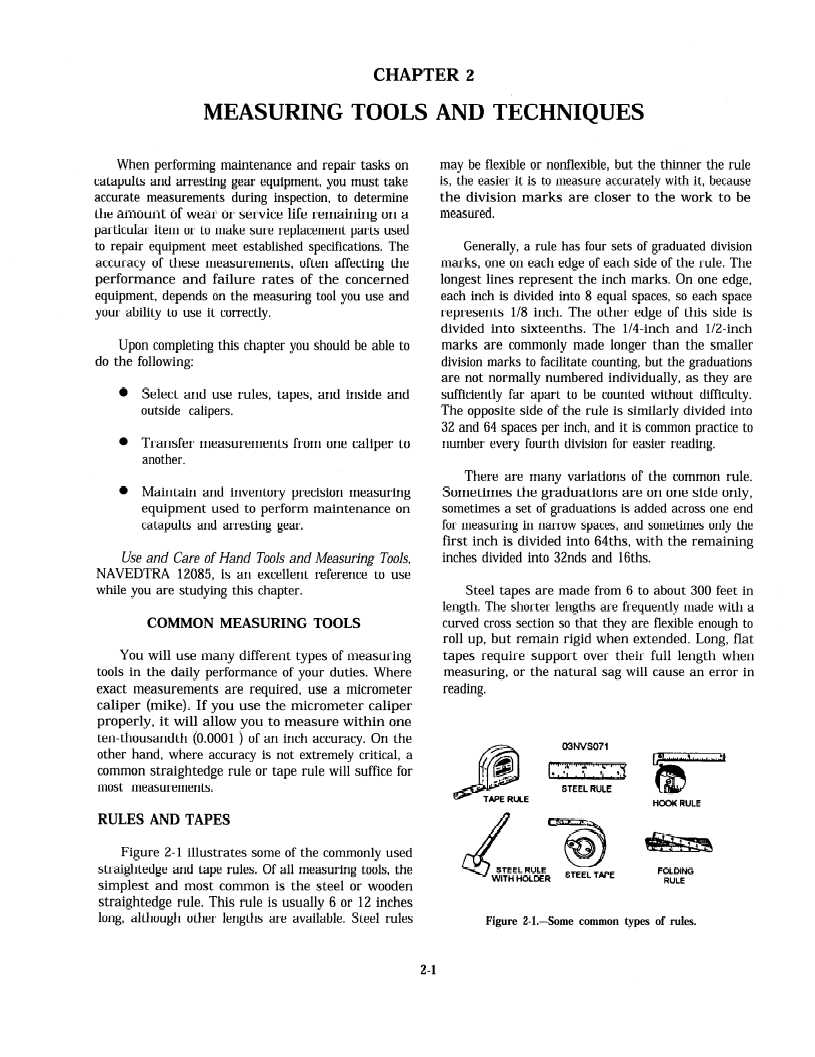CHAPTER
2
MEASURINGTOOLSANDTECHNIQUES
When performing maintenance and repair tasks on
catapults and arresting gear equipment, you must take
accurate measurements during inspection, to determine
the amount of wear or service life remaining
on a
particular item or to make sure replacement parts used
to repair equipment meet established specifications. The
accuracy of these measurements, often affecting the
performance
and failure
rates of the concerned
equipment, depends on the measuring tool you use and
your ability to use it correctly.
Upon completing this chapter you should be able to
do the following:
l
Select and use rules, tapes, and inside and
outside calipers.
l
Transfer measurements from one caliper to
another.
l
Maintain
and inventory precision measuring
equipment used to perform maintenance on
catapults and arresting gear.
Use and Care of Hand Tools and Measuring Tools,
NAVEDTRA 12085, is an excellent reference to use
while you are studying this chapter.
COMMON
MEASURING
TOOLS
You will use many different types of measuring
tools in the daily performance of your duties. Where
exact measurements are required, use a micrometer
caliper
(mike). If you use the micrometer
caliper
properly,
it will allow you to measure within
one
ten-thousandth
(0.0001 ) of an inch accuracy. On the
other hand, where accuracy is not extremely critical, a
common straightedge rule or tape rule will suffice for
most measurements.
RULES AND TAPES
Figure 2-l illustrates some of the commonly used
straightedge and tape rules. Of all measuring tools, the
simplest and most common is the steel or wooden
straightedge rule. This rule is usually 6 or 12 inches
long, although other lengths are available. Steel rules
may be flexible or nonflexible, but the thinner the rule
is, the easier it is to measure accurately with it, because
the division
marks are closer to the work to be
measured.
Generally, a rule has four sets of graduated division
marks, one on each edge of each side of the rule. The
longest lines represent the inch marks. On one edge,
each inch is divided into 8 equal spaces, so each space
represents l/8 inch. The other edge of this side is
divided into sixteenths. The l/$-inch
and l/2-inch
marks are commonly made longer than the smaller
division marks to facilitate counting, but the graduations
are not normally numbered individually,
as they are
sufficiently far apart to be counted without difficulty.
The opposite side of the rule is similarly divided into
32 and 64 spaces per inch, and it is common practice to
number every fourth division for easier reading.
There are many variations of the common rule.
Sometimes the graduations
are on one side only,
sometimes a set of graduations is added across one end
for measuring in narrow spaces,
and sometimes
only the
first inch is divided into 64ths, with the remaining
inches divided into 32nds and 16ths.
Steel tapes are made from 6 to about 300 feet in
length. The shorter lengths are frequently made with a
curved cross section so that they are flexible enough to
roll up, but remain rigid when extended. Long, flat
tapes require support over their full length when
measuring, or the natural sag will cause an error in
reading.
a3Nvso71
rLm
STEEL RULE
a’
r
HOOK RULE
FOLDING
RULE
Figure Z-l.-Some
common types of rules.
2-1


